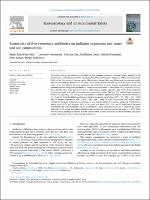Por favor, use este identificador para citar o enlazar este ítem:
https://repositorio.usj.es/handle/123456789/1149
| Título : | Ecotoxicity of five veterinary antibiotics on indicator organisms and water and soil communities |
| Autor: | Pino Otín, Rosa


Valenzuela, Antonio Gan, Cristina 


Lorca, Guillermo Ferrando Lázaro, Natalia 


Langa Morales, Elisa 

Ballestero Fernández, Diego |
| Fecha de publicación: | 5-mar-2023 |
| Editorial : | Elsevier |
| Citación : | María Rosa Pino-Otín, Antonio Valenzuela, Cristina Gan, Guillermo Lorca, Natalia Ferrando, Elisa Langa, Diego Ballestero, Ecotoxicity of five veterinary antibiotics on indicator organisms and water and soil communities, Ecotoxicology and Environmental Safety, Volume 274, 2024, 116185, ISSN 0147-6513,https://doi.org/10.1016/j.ecoenv.2024.116185. |
| Resumen : | This study explores the environmental effects of five common veterinary antibiotics widely detected in the environment, (chlortetracycline,CTC; oxytetracycline,OTC; florfenicol,FF; neomycin, NMC; and sulfadiazine, SDZ) on four bioindicators: Daphnia magna, Vibrio fischeri, Eisenia fetida, and Allium cepa, representing aquatic and soil environments. Additionally, microbial communities characterized through 16 S rRNA gene sequencing from a river and natural soil were exposed to the antibiotics to assess changes in population growth and metabolic profiles using Biolog EcoPlates™. Tetracyclines are harmful to Vibrio fisheri (LC50 ranges of 15–25 μg/ mL), and the other three antibiotics seem to only affect D. magna, especially, SDZ. None of the antibiotics produced mortality in E. fetida at concentrations below 1000 mg/kg. NMC and CTC had the highest phytotoxicities in A. cepa (LC50 = 97–174 μg/mL, respectively). Antibiotics significantly reduced bacterial metabolism at 0.1–10 μg/mL. From the highest to the lowest toxicity on aquatic communities: OTC > FF > SDZ ≈ CTC > NMC and on edaphic communities: CTC ≈ OTC > FF > SDZ > NMC. In river communities, OTC and FF caused substantial decreases in bacterial metabolism at low concentrations (0.1 μg/mL), impacting carbohydrates, amino acids (OTC), and polymers (FF). At 10 μg/mL and above, OTC, CTC, and FF significantly decreased metabolizing all tested metabolites. In soil communities, a more pronounced decrease in metabolizing ability, detectable at 0.1 μg/mL, particularly affected amines/amides and carboxylic and ketonic acids (p < 0.05). These new ecotoxicity findings underscore that the concentrations of these antibiotics in the environment can significantly impact both aquatic and terrestrial ecosystems. |
| URI : | https://repositorio.usj.es/handle/123456789/1149 |
| ISSN : | 0147-6513 |
| Aparece en las colecciones: | Artículos de revistas |
Ficheros en este ítem:
| Fichero | Descripción | Tamaño | Formato | |
|---|---|---|---|---|
| Ecotoxicity of five veterinary antibiotics on indicator organisms and water and soil communities.pdf | 8,89 MB | Adobe PDF |  Visualizar/Abrir |
Este ítem está sujeto a una licencia Creative Commons Licencia Creative Commons

